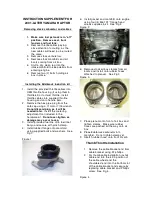
1. Radiator coolant may be extremely hot. Do not open the system while hot, or scalding engine coolant could gush
out, causing personal injury. Allowthe vehicle to cool before servicing this system.
2. When the tester is removed, be careful not to spill any coolant from it.
3. Be sure to clean away completely any coolant from the area.
4. Be careful, when installing and removing the tester and when testing, not to deform the filler neck of the radiator.
4. If there is leakage, repair or replace with the apropriate part.
RADIATOR CAP PRESSURE TEST
1. Use an adapter to attach the cap to the tester.
2. Increase the pressure until the indicator of the gauge stops moving.
Main valve opening pressure :
107.9 ± 14.7kPa (1.1 ± 0.15kg/cm² , 15.64 ± 2.13psi)
Main valve closing pressure :
83.4 kPa (0.85 kg/cm², 12.1 psi
3. Check that the pressure level is maintained at or above the limit.
4. Replace the radiator cap if the reading does not remain at or above the limit.
Be sure that the cap is clean before testing, since rust or other foreign material on the cap seal will cause an incorrect
reading.
SPECIFIC GRAVITY TEST
1. Measure the specific gravity of the coolant with a hydrometer.
2. Measure the coolant temperature and calculate the concentration from the relation between the specific gravity and
temperature. Use the followingtable for reference.
RELATION BETWEEN COOLANT CONCENTRATION AND SPECIFIC GRAVITY
Page 8 of 12
24.04.2008
http://www.hmaservice.com/viewer/content.asp?IsPrint=true&imgnum=1&print_title...
















































